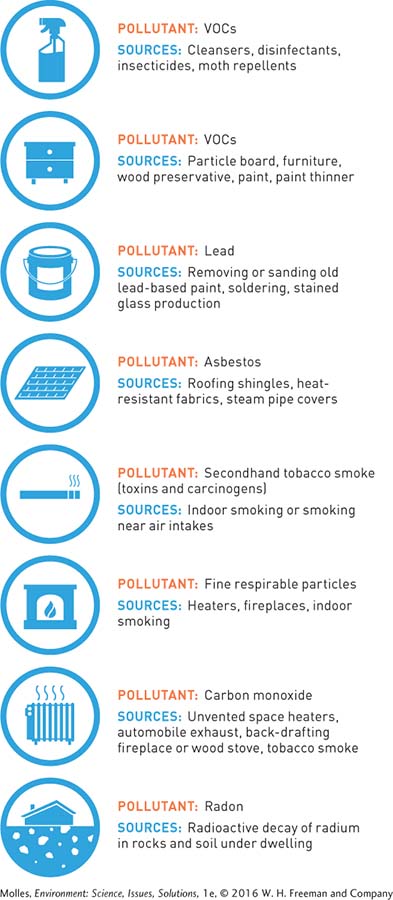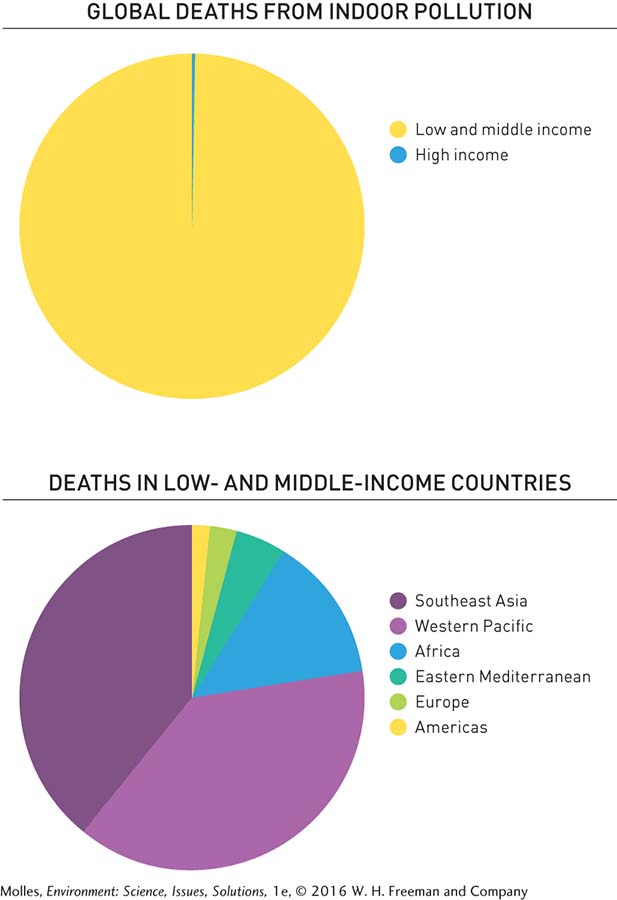13.4 Air pollution exacts major health-
13.4–
400
The problem of pollution is not a new one for humanity. Traces of heavy metals, for instance, still linger in the soils around Roman smelters dating back more than 2,000 years. But the scope and diversity of pollutants increased with the Industrial Revolution and the growing human population.
One of the most infamous examples of pollution comes from the small town of Sudbury, Ontario. In the early 20th century, the nickel and copper mining industry there was booming. Metals were extracted from their ores through a process called open bed roasting, in which ore was heaped on a pile of burning logs that would smolder for months, releasing gaseous fumes containing sulfur dioxide, which in turn caused acid deposition. When a reporter visited in 1908, he called Sudbury “one of the most unattractive places under the sun, for the sulphur fumes . . . have destroyed vegetation in the whole locality, leaving the rocky hills bare of trees and the streets and lawns innocent of a blade of grass.” By the 1970s, the land was left so desolate and devoid of life that NASA used it as a place to practice landing on the moon. Today, in the middle of the Anthropocene era, it is almost impossible to find a place on Earth that our pollution has not touched.
indoor air pollution A serious threat to human health resulting from the buildup of pollutants in the indoor environment.
Pollution damages ecosystems and human infrastructure, both of which result in significant economic costs. It also seriously impacts human health. According to the World Health Organization (WHO), air pollution kills over 7 million people each year—
The Toll of Indoor Air Pollution
sick building syndrome A circumstance in which many building occupants experience symptoms of illness (e.g., headaches, respiratory and eye irritation, nausea) for which no specific cause has been identified.
Pollution is not something that only happens outside. Less air exchange indoors allows a variety of pollutants to build up inside buildings, potentially rising to unhealthy concentrations. The indoor pollutants of concern include VOCs, carbon monoxide (CO), radon, asbestos, and tobacco smoke (Figure 13.15). Sick building syndrome is a circumstance in which many building occupants experience symptoms of illness, such as headaches, respiratory and eye irritation, and nausea, for which no specific cause has been identified. Sick building syndrome has been frequently observed in new buildings in which many of the recently constructed components are still releasing significant amounts of VOCs from adhesives, plastics, and other materials.

401
Indoor air pollution is especially severe in developing countries. Nearly 3 billion people in developing countries rely on open fires or inefficient stoves, where they burn biomass, animal dung, or coal indoors. The resulting indoor air pollution takes a tremendous health toll. The WHO estimates that in 2012 alone, over 4 million people exposed to indoor air pollution, primarily in low-

Economic Costs of Air Pollution

In today’s increasingly interconnected world, what environmental damages are external to the global economy?
The damage caused by air pollution, including ill health and shortened lives, comes with real economic costs. These costs can be estimated in terms of deterioration of infrastructure, such as buildings and bridges, reduced agricultural or forest productivity, loss of valuable commercial or recreational fisheries, and so forth. Other costs are related to the impacts of pollution on human health and longevity. For example, the loss of work time due to chronic illness or premature death reduces worker productivity and generates costs related to health care. These and many other types of damages, referred to as externalities in Chapter 2 (see page 49), are estimated to significantly reduce gross domestic product (GDP), the economic bottom line for nations. These costs have not been reliably estimated for all pollutants or for every economy. However, a substantial amount of work has been done to estimate the costs for some of the major sources of pollution in the United States and China, the two largest national economies.
Costs of Air Pollution in the United States
Nicholas Muller and Robert Mendelsohn of the Yale School of Forestry and Environmental Studies estimated the costs of damages created by six common air pollutants: ammonia, fine and coarse particulates, sulfur dioxide, nitrogen dioxide, and VOCs. Making such an estimate for the lower 48 United States was no small task. First, Muller and Mendelsohn had to calculate the concentrations of pollutants across the country and then, using population information, estimate the number and level of exposures of people to the pollutants. Next, they converted exposure levels to likely effects on human mortality, disease rates (morbidity), agriculture, timber production, visibility, structural materials, and recreation. The final step in the analysis was to estimate the economic value of these physical damages. They repeated this analysis for each of the six pollutants at 10,000 locations across the country.
Muller and Mendelsohn’s calculations resulted in an estimate of annual damages by the six pollutants, which they called gross annual damages, or GAD. Summing their estimates for the six common pollutants, Muller and Mendelsohn estimated the GAD for the United States in 2002—
Costs of Air Pollution in China
China’s economic growth can be described as nothing less than explosive. However, with this growth has come a massive increase in pollution (see introduction, page 386). Concerned about rising pollution levels, China approached the World Bank in 2003 about studying the cost of pollution to the country in terms of impacts on health and nonhealth sectors of the economy. In its study, the World Bank team worked closely with China’s ministries of agriculture, health and water resources and that nation’s own State Environmental Protection Administration.
402
One of the key findings of the 2007 study was that rising air pollution accounts for increases in lung disease, including cancer, leading to increased rates of absenteeism in schools and the workplace. Increasing levels of water pollution correlate with higher levels of diarrhea, especially in children under 5, and cancers. The report concludes that by degrading water quality, pollution is worsening China’s chronically short water supplies. According to the World Bank study, the combined costs of air and water pollution in 2003 amounted to approximately $100 billion, or about 5.8% of China’s GDP that year. The estimated costs were 4.3% of GDP for health-
Think About It
How might construction companies increase their business share by promoting the use of low-
VOC materials in their buildings? What are the potential negative consequences of quantifying pollution’s impact in terms of GDP?
What factors may contribute to a higher impact of pollution on China’s contemporary economy compared with that of the United States?